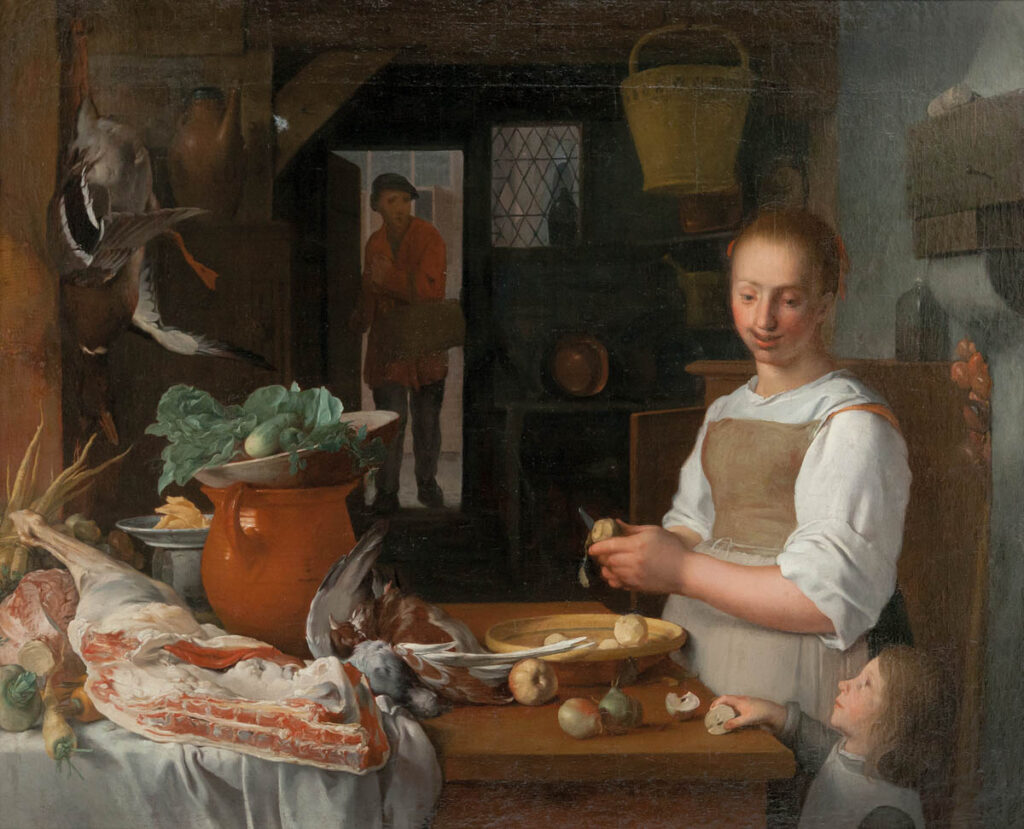
In working with classes of first and second graders this fall, I’ve noted how enthusiastically they respond to that which is “real.” Genuine objects placed before their eyes seem to astonish and delight them: for example, placing before them actual large, framed oil paintings, watercolors, busts, and small objects of art.
The materials can be quite ordinary objects, too: cardboard for making matting, pieces of canvas, or tubes of pigment. Recently the kids were fascinated by a motley collection of “autumn props” I brought into the classroom. I asked them to select objects from different categories (tall, short, vivid, neutral color, lateral, dangling), and arrange them into a “still-life.” That was Part One. Working in teams as they did, it was a slightly chaotic part, as you might imagine. Then I asked them individually to attempt to draw their masterpieces. I confess to being surprised by the excellent drawings they made.
More than anything, though, I was struck by their initial utterances as I unpacked my bags to pull out gourds and pumpkins, acorn squash and apples, lemons and onions, dried flowers and Indian corn, clusters of grapes, small pots of draping ivy, and a smattering of ceramic vases and wooden bowls. Little voices around the room kept uttering to no one in particular: “Is this real?” “Are those real?”
The word genuine is not in the common parlance of most little children. But essentially, these children were struck by the fact that I have been placing real objects—genuine objects—before them throughout this series of lessons and asking them to interact with them.
Reality is elusive for little children. They are doing well to figure out what day it is, not to mention what day comes tomorrow. Truth be told, we grownups have our own version of this problem, intensified across recent years as technology dulls our minds and senses. Washed by waves of technological forces, where can we go to escape to the genuine?
Children feel the effect of this technological dulling keenly. After all, nearly every adult they see is wrapped around a cell phone. And while those phones may hold 6000 photos, how many of them are enlarged and framed to be cherished across years of hanging in the living room or gracing a bookshelf or bedroom dresser?
So, rather than go on with examples of the problem, let’s try an experiment. Moving into Advent, now is a good time to stretch our minds and grow in spirit. Whether you have little kids, big ones, or only yourself to consider, think about hauling genuine experiences back into your daily life. For example, make some real whipped cream for a change: nothing is easier than beating heavy cream, popping in a few drops of vanilla, a spoonful of sugar (or not), and netting a bowl of delectable fluff (and it’s pretty healthy too).
Let the kids experience some real housework: have them clean the rug without a vacuum. Try to wash a full load of laundry by hand—maybe in a bucket, maybe in a laundry sink or bathtub. Don’t leave out the sheets and towels either (this may get them to hang up towels and wear things twice). On a cheerier note, squeeze juice with a hand press, put spices into a sachet to add fragrance to a drawer, find a fountain pen—especially one that fills from a bottle of ink—and write a letter. (For that matter, what better time to write a real letter to someone on elegant paper?) Pull apart an old shirt to observe what the pieces of fabric comprising it really look like when spread flat. Husk a pile of corn instead of opening a can and see how much extra excitement it generates about that corn casserole.
The possibilities for exploring the genuine are endless. Fortunately, it doesn’t matter what you choose to do. The goal is simply to draw closer to the “genuine,” to dilute dullness and the fog of apathy, and to enlarge and invigorate our experiences.
It goes without saying that this experiment works best with the digital media turned off! Genuine activities like singing songs without Alexa, finding our way with a map and some sense of North and South, sprouting seeds instead of buying the same plants 4-inches tall at the nursery—any of these actions give us a deeper appreciation for reality. They also show us how much effort it used to take to accomplish virtually anything in former times.
Doing genuine things also helps us understand why our forefathers hankered after beauty and the sublime. They instinctively knew that music, art, and poetry healed the soul and refreshed the body. They knew that singing doesn’t just delight the ear and heart: it draws oxygen into the lungs, clears the mind, and reinvigorates our limbs. Skipping and dancing across the threshold, as opposed to dragging ourselves into the house after a long day, can change entirely the atmosphere of the evening before us.
Meanwhile, I’m going to keep bringing fragile, unexpected real things into the classrooms. Maybe it is foolish. Definitely it is messy. But I cannot do otherwise if I want to see children’s faces light up with each presentation. They are forming a bond with art and with beauty: they are apprehending, responding to, and feeding upon art and beauty. And that banquet is best served with things that are genuine.



